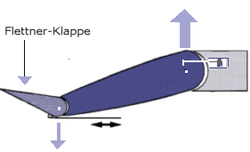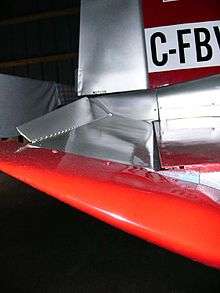Servo tab

A servo tab is a small hinged device installed on an aircraft control surface to assist the movement of the control surfaces. Introduced by the German firm Flettner, servo tabs were formerly known as Flettner tabs. Servo tabs are not true servomechanisms, as they do not employ negative feedback to keep the control surfaces in a desired position; they only provide a mechanical advantage to the pilot.
Servo tabs
Servo tabs move in the opposite direction of the control surface. The tab has a leverage advantage, being located well aft of the surface hinge line, and thus can use the relative airflow to deflect the control surface in the opposite direction. This has the effect of reducing the control force required by the pilot to move the controls.[1][2]
In the case of some large aircraft the servo tab is the only control that is connected to the pilot's stick or wheel, as in the Bristol Britannia and its Canadian derivatives. The pilot moves the wheel which moves the servo tab and then the servo tab, using its mechanical advantage, moves the elevator or aileron, which is otherwise free-floating. With a servo-tab variant named "geared spring tab", a pilot is able "to maneuver a vehicle weighing as much as 300,000 pounds flying at an airspeed of 300 miles per hour or more".[3]
Anti-servo tabs

An anti-servo tab, or anti-balance tab, works in the opposite way to a servo tab. It deploys in the same direction as the control surface, making the movement of the control surface more difficult and requires more force applied to the controls by the pilot. This may seem counter-productive, but it is commonly used on aircraft where the controls are too light or the aircraft requires additional stability in that axis of movement. The anti-servo tab serves mainly to make the controls heavier in feel to the pilot[4] and also to increase stability.[5] An anti-servo tab also functions as a trim device to relieve control pressure and maintain the stabilator in the desired position.[2][6]
See also
References
- ↑ Crane, Dale: Dictionary of Aeronautical Terms, third edition, p. 456. Aviation Supplies & Academics, 1997. ISBN 1-56027-287-2
- 1 2 From the Ground Up, 27th Revised Edition, Aviation Publishers, Ottawa, Ontario, Canada, 1996, p. 14.
- ↑ W.H. Phillips, A Career at NASA Langley Research Center, Chapter 6, "The Quest for Reduced Control Forces" and Naca Rep. 794 (1944)
- ↑ Stick force per g
- ↑ Crane, Dale: Dictionary of Aeronautical Terms, third edition, p. 34. Aviation Supplies & Academics, 1997. ISBN 1-56027-287-2
- ↑ "Antiservo Tabs". Pilot's Handbook of Aeronautical Knowledge (FAA). AeroManual.com. Retrieved 2014-07-17.
External links
- The Quest for Reduced Control Forces (NASA) — Monographs in Aerospace History: William Hewitt Phillips. A thorough dissertation on the reduction of control forces in high speed and large aircraft in the 1940s, with excellent links to NACA reports of the time, holding present day validity